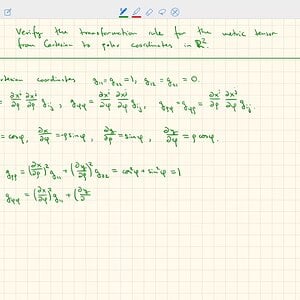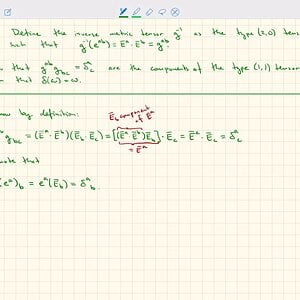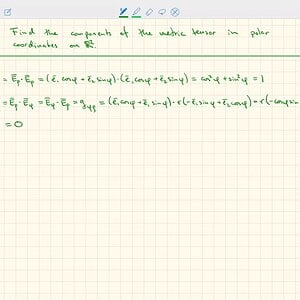You are using an out of date browser. It may not display this or other websites correctly.
You should upgrade or use an alternative browser.
You should upgrade or use an alternative browser.
What is Metric tensor: Definition and 200 Discussions
In the mathematical field of differential geometry, one definition of a metric tensor is a type of function which takes as input a pair of tangent vectors v and w at a point of a surface (or higher dimensional differentiable manifold) and produces a real number scalar g(v, w) in a way that generalizes many of the familiar properties of the dot product of vectors in Euclidean space. In the same way as a dot product, metric tensors are used to define the length of and angle between tangent vectors. Through integration, the metric tensor allows one to define and compute the length of curves on the manifold.
A metric tensor is called positive-definite if it assigns a positive value g(v, v) > 0 to every nonzero vector v. A manifold equipped with a positive-definite metric tensor is known as a Riemannian manifold. On a Riemannian manifold, the curve connecting two points that (locally) has the smallest length is called a geodesic, and its length is the distance that a passenger in the manifold needs to traverse to go from one point to the other. Equipped with this notion of length, a Riemannian manifold is a metric space, meaning that it has a distance function d(p, q) whose value at a pair of points p and q is the distance from p to q. Conversely, the metric tensor itself is the derivative of the distance function (taken in a suitable manner). Thus the metric tensor gives the infinitesimal distance on the manifold.
While the notion of a metric tensor was known in some sense to mathematicians such as Carl Gauss from the early 19th century, it was not until the early 20th century that its properties as a tensor were understood by, in particular, Gregorio Ricci-Curbastro and Tullio Levi-Civita, who first codified the notion of a tensor. The metric tensor is an example of a tensor field.
The components of a metric tensor in a coordinate basis take on the form of a symmetric matrix whose entries transform covariantly under changes to the coordinate system. Thus a metric tensor is a covariant symmetric tensor. From the coordinate-independent point of view, a metric tensor field is defined to be a nondegenerate symmetric bilinear form on each tangent space that varies smoothly from point to point.
View More On Wikipedia.org
A metric tensor is called positive-definite if it assigns a positive value g(v, v) > 0 to every nonzero vector v. A manifold equipped with a positive-definite metric tensor is known as a Riemannian manifold. On a Riemannian manifold, the curve connecting two points that (locally) has the smallest length is called a geodesic, and its length is the distance that a passenger in the manifold needs to traverse to go from one point to the other. Equipped with this notion of length, a Riemannian manifold is a metric space, meaning that it has a distance function d(p, q) whose value at a pair of points p and q is the distance from p to q. Conversely, the metric tensor itself is the derivative of the distance function (taken in a suitable manner). Thus the metric tensor gives the infinitesimal distance on the manifold.
While the notion of a metric tensor was known in some sense to mathematicians such as Carl Gauss from the early 19th century, it was not until the early 20th century that its properties as a tensor were understood by, in particular, Gregorio Ricci-Curbastro and Tullio Levi-Civita, who first codified the notion of a tensor. The metric tensor is an example of a tensor field.
The components of a metric tensor in a coordinate basis take on the form of a symmetric matrix whose entries transform covariantly under changes to the coordinate system. Thus a metric tensor is a covariant symmetric tensor. From the coordinate-independent point of view, a metric tensor field is defined to be a nondegenerate symmetric bilinear form on each tangent space that varies smoothly from point to point.
View More On Wikipedia.org
-

I On the physical meaning of Minkowski's spacetime model
Hi, I was thinking about the following. Suppose we have a geometric mathematical model of spacetime such that there exists a global map ##(t,x_1,x_2,x_3)## in which the metric tensor is in the form $$ds^2 = c^2dt^2 - (dx_1)^2 + (dx_2)^2 + (dx_3)^2$$ i.e. the metric is in Minkowski form...- cianfa72
- Thread
- Replies: 26
- Forum: Special and General Relativity
-

I Do Metric Tensors Always Have Inverses?
I am reading about musical isomorphisms and for the demonstration of the index raising operation from the sharp isomorphism, we have to multiply the equation by the inverse matrix of the metric. Can we assume that this inverse always exists? If so, how could I prove it?- jv07cs
- Thread
- Replies: 8
- Forum: Linear and Abstract Algebra
-
E
I A question about an Identity
In dimensional regularization I have seen this relation ##k^{\mu}k^{\nu}=\frac{1}{D}g^{\mu\nu}k^2## but this seems to hold for same types of four vectors k. Is there any similar identity for different vectors like ##k^{\mu}p^{\nu}=\frac{1}{D}g^{\mu\nu}k.p## ?- Elmo
- Thread
-
- Tags
- Metric tensor
- Replies: 10
- Forum: High Energy, Nuclear, Particle Physics
-

B Creating Metric Describing Large Disk
How can I create a metric describing the space outside a large disk, like an elliptical galaxy? In cylindrical coordinates, ##\phi## would be the angle restricted the the plane, as ##\rho## would be the radius restricted to the plane. I think that if ##z## is suppressed to create an embedding...- Onyx
- Thread
- Replies: 3
- Forum: Special and General Relativity
-
P
A Exploring a QM particle in Motion with GR
I encountered a problem in reading Phys.Lett.B Vol.755, 367-370 (2016). I cannot derive Eq.(7), the following snapshot is the paper and my oen derivation, I cannot repeat Eq.(7) in the paper. ##g^{\mu\nu}## is diagonal metric tensor and##g^{\mu\mu}## is the function of ##\mu## only...- PRB147
- Thread
- Replies: 8
- Forum: Quantum Physics
-

I Action of metric tensor on Levi-Civita symbol
We know that a metric tensor raises or lowers the indices of a tensor, for e.g. a Levi-Civita tensor. If we are in ##4D## spacetime, then \begin{align} g_{mn}\epsilon^{npqr}=\epsilon_{m}{}^{pqr} \end{align} where ##g_{mn}## is the metric and ##\epsilon^{npqr}## is the Levi-Civita tensor. The...- Baela
- Thread
- Replies: 11
- Forum: Special and General Relativity
-

B What is the metric for a bag-of-gold spacetime?
What is the metric for a bag-of-gold spacetime?- Onyx
- Thread
- Replies: 9
- Forum: Special and General Relativity
-

B Intra-Universe Wormhole Metrics
Are there any metrics for intra-universe wormholes?- Onyx
- Thread
- Replies: 13
- Forum: Special and General Relativity
-

B Find Geodesics in Dynamic Ellis Orbits Metric
Does anyone see a way I can find geodesics in the metric ##ds^2=-dt^2+dp^2+(5p^2+4t^2)d\phi^2## (ones with nonzero angular momentum)? I'm hoping it can be done analytically, but that may be wishful thinking. FYI, this is the metric listed at the bottom of the Wikipedia article about Ellis Wormholes.- Onyx
- Thread
- Replies: 92
- Forum: Special and General Relativity
-

B Calculate Unit Normal Vector for Metric Tensor
How do I calculate the unit normal vector for any metric tensor?- Onyx
- Thread
- Replies: 21
- Forum: Special and General Relativity
-

B Calc. Christoffel Symbols of Hiscock Coordinates
The Hiscock coordinates read: $$d\tau=(1+\frac{v^2(1-f)}{1-v^2(1-f)^2})dt-\frac{v(1-f)}{1-v^2(1-f)^2}dx$$ ##dr=dx-vdt## Where ##f## is a function of ##r##. Now, in terms of calculating the christoffel symbol ##\Gamma^\tau_{\tau\tau}## of the new metric, where ##g_{\tau\tau}=v^2(1-f)^2-1## and...- Onyx
- Thread
- Replies: 11
- Forum: Special and General Relativity
-

I Calculating Spacetime Around Multiple Objects
In describing the spacetime around a massive, spherical object, one would use the Schwarzschild Metric. What metric would instead be used to describe the spacetime around multiple massive bodies? Say, for example, you want to calculate the Gravitational Time Dilation experienced by a rocket ship...- Sciencemaster
- Thread
- Replies: 7
- Forum: Special and General Relativity
-

B Sign of Expansion Scalar in Expanding FLRW Universe
Considering the FLWR metric in cartesian coordinates: ##ds^2=-dt^2+a^2(t)(dx^2+dy^2+dz^2)## With ##a(t)=t##, the trace of the extrinsic curvature tensor is ##-3t##. But why is it negative if it's describing an expanding universe, not a contracting one?- Onyx
- Thread
- Replies: 35
- Forum: Special and General Relativity
-

Insights Yardsticks to Metric Tensor Fields
Continue reading...- fresh_42
- Thread
-
- Tags
- Fields Metric Metric tensor Tensor
- Replies: 7
- Forum: General Math
-

I Calculate Gaussian Curvature from 4D Metric Tensor
I've been trying to find a way to calculate Gaussian curvature from a 4D metric tensor. I found a program that does this in Mathematica using the Brioschi formula. However, this only seems to work for a 2D metric or formula (I would need to use something with more dimensions). I've found...- Sciencemaster
- Thread
- Replies: 14
- Forum: Special and General Relativity
-

A Proper Volume on Constant Hypersurface in Alcubierre Metric
I'm wondering if there is a way to find the proper volume of the warped region of the Alcubierre spacetime for a constant ##t## hypersurface. I can do a coordinate transformation ##t=τ+G(x)##, where ##G(x)=\int \frac{-vf}{1-v^2f^2}dx##. This eliminates the diagonal and makes it so that the...- Onyx
- Thread
- Replies: 7
- Forum: Special and General Relativity
-
C
I Calculating Relative Change in Travel Time Due to Spacetime Perturbation
Suppose you have the following situation: We have a spacetime that is asymptotically flat. At some position A which is in the region that is approximately flat, an observer sends out a photon (for simplicity, as I presume that any calculations involved here become easier if we consider a...- cicero
- Thread
- Replies: 3
- Forum: Special and General Relativity
-

SH2372 General Relativity - Lecture 4
0:00 The metric tensor 12:55 Curve lengths 28:17 Metric compatibility of connections 35:47 The Levi-Civita connection 40:27 Induced metrics 50:12 Curvature and the metric 1:04:18 Killing fields and symmetries- Orodruin
- Media item
- Curvature tensor Metric tensor
- Comments: 0
- Category: Relativity
-

SH2372 General Relativity (7X): Coordinate transformation of metric components
- Orodruin
- Media item
- Coordinate transformation Metric tensor
- Comments: 0
- Category: Relativity
-

SH2372 General Relativity (6X): The inverse metric tensor
- Orodruin
- Media item
- Metric tensor
- Comments: 0
- Category: Relativity
-

SH2372 General Relativity (5X): Metric components in polar coordinates
- Orodruin
- Media item
- Metric tensor Polar coordinates
- Comments: 0
- Category: Relativity
-

I Raising/Lowering Indices w/ Metric Tensor
I'm still confused about the notation used for operations involving tensors. Consider the following simple example: $$\eta^{\mu \sigma} A_{\mu \nu} = A_{\mu \nu} \eta^{\mu \sigma}$$ Using the rules for raising an index through the (inverse) metric tensor ##\eta^{\mu \sigma}## we get...- cianfa72
- Thread
-
- Tags
- Indices Metric Metric tensor Tensor
- Replies: 8
- Forum: Special and General Relativity
-

Derivative of Determinant of Metric Tensor With Respect to Entries
We know that the cofactor of determinant ##A##, is $$\frac{\partial A}{\partial a^{r}_{i}} = A^{i}_{r} = \frac{1}{2 !}\delta^{ijk}_{rst} a^{s}_{j} a^{t}_{k} = \frac{1}{2 !}e^{ijk} e_{rst} a^{s}_{j} a^{t}_{k}$$ By analogy, $$\frac{\partial Z}{\partial Z_{ij}} = \frac{1}{2 !}e^{ikl} e^{jmn}...- yucheng
- Thread
- Replies: 14
- Forum: Calculus and Beyond Homework Help
-

I Variation of Four-Velocity Vector w/ Respect to Metric Tensor
Hi everyone! I'm having some difficulty showing that the variation of the four-velocity, Uμ=dxμ/dτ with respect the metric tensor gαβ is δUμ=1/2 UμδgαβUαUβ Does anyone have any suggestion? Cheers, Rafael. PD: Thanks in advances for your answers; this is my first post! I think ill be...- Hubble_92
- Thread
- Replies: 2
- Forum: Special and General Relativity
-
A
I Deriving Contravariant Form of Levi-Civita Tensor
The covariant form for the Levi-Civita is defined as ##\varepsilon_{i,j,k}:=\sqrt{g}\epsilon_{i,j,k}##. I want to show from this definition that it's contravariant form is given by ##\varepsilon^{i,j,k}=\frac{1}{\sqrt{g}}\epsilon^{i,j,k}##.My attemptWhat I have tried is to express this tensor...- AndersF
- Thread
- Replies: 1
- Forum: Special and General Relativity
-
A
I Showing Determinant of Metric Tensor is a Tensor Density
I'm trying to show that the determinant ##g \equiv \det(g_{ij})## of the metric tensor is a tensor density. Therefore, in order to do that, I need to show that the determinant of the metric tensor in the new basis, ##g'##, would be given by...- AndersF
- Thread
- Replies: 4
- Forum: Special and General Relativity
-
A
I Expressing Vectors of Dual Basis w/Metric Tensor
I'm trying to understand why it is possible to express vectors ##\mathbf{e}^i## of the dual basis in terms of the vectors ##\mathbf{e}_j## of the original basis through the dual metric tensor ##g^{ij}##, and vice versa, in these ways: ##\mathbf{e}^i=g^{ij}\mathbf{e}_j##...- AndersF
- Thread
- Replies: 8
- Forum: Special and General Relativity
-

A Deriving Essential Quantities from Metric Tensor for GR Calculations
I am working on a computational project about General Relativity. In this process, I want to code 'the stuff' that can be derivable from the metric tensor. So far, I have coded Riemann Tensor, Weyl Tensor, Einstein Tensors, Ricci Tensor, Ricci scalar. What are the other essential/needed...- Arman777
- Thread
-
- Tags
- Metric Metric tensor Tensor
- Replies: 20
- Forum: Special and General Relativity
-
A
Divergence in Spherical Coordinate System by Metric Tensor
The result equation doesn't fit with the familiar divergence form that are usually used in electrodynamics. I want to know the reason why I was wrong. My professor says about transformation of components. But I cannot close to answer by using this hint, because I don't have any idea about "x"...- Astrocyte
- Thread
- Replies: 2
- Forum: Advanced Physics Homework Help
-

B Metric tensor for a uniformly accelerated observer
Hello all, let's suppose we have, in a flat spacetime, two observers O and O', the latter speeding away from O, with an uniform acceleration ##a##. In the Minkowski spacetime chart of O, the world-line of O' can be drawn as a parable. We know that the Lorentz boost at every point of the...- Pyter
- Thread
- Replies: 55
- Forum: Special and General Relativity
-

I Argument for Existence of Normal Coordinates at a Point
Hey there, I've been recently been going back over the basics of GR, differential geometry in particular. I was watching one of Susskind's lectures and did not understand the argument made here (26:33 - 35:40). In short, the argument goes as follows (I think): we have some generic metric ##{ g...- tomdodd4598
- Thread
- Replies: 2
- Forum: Special and General Relativity
-
Q
I Metric Tensor: Symmetry & Other Constraints
Aside from being symmetric, are there any other mathematical constraints on the metric?- quickAndLucky
- Thread
- Replies: 10
- Forum: Special and General Relativity
-
Q
A Variation of Metric Tensor Under Coord Transf | 65 chars
Under the coordinate transformation $\bar x=x+\varepsilon$, the variation of the metric $g^{\mu\nu}$ is: $$ \delta g^{\mu\nu}(x)=\bar g^{\mu\nu}(x)-g^{\mu\nu}(x)=-\frac{\partial{ g^{\mu\nu}}}{\partial x^{\alpha}}\varepsilon^{\alpha}+ g^{\mu\beta}\frac{\partial \varepsilon^{\nu}}{\partial...- QipshaqUli
- Thread
- Replies: 1
- Forum: Special and General Relativity
-
P
Show that the metric tensor is independent of coordinate choice
I need to use some property of the relalation between the coordinate systems to prove that g_{hk} is independent of the choice of the underlying rectangular coordinate system. I will try to borrow an idea from basic linear algebra. I expect any transformation between the rectangular systems to...- PrecPoint
- Thread
- Replies: 3
- Forum: Advanced Physics Homework Help
-
W
Solving Metric Tensor Problems: My Attempt at g_μν for (2)
My attempt at ##g_{\mu \nu}## for (2) was \begin{pmatrix} -(1-r^2) & 0 & 0 & 0 \\ 0 &\frac{1}{1-r^2} & 0 & 0 \\ 0 & 0 & r^2 & 0 \\ 0 & 0 & 0 & r^2 \sin^2(\theta) \end{pmatrix} and the inverse is the reciprocal of the diagonal elements. For (1) however, I can't even think of how to write the...- WWCY
- Thread
-
- Tags
- Metric Metric tensor Tensor
- Replies: 4
- Forum: Advanced Physics Homework Help
-

A Anisotropic Universe and Friedmann Equations
The Friedman Equations is based on the cosmological principle, which states that the universe at sufficiently large scale is homogeneous and isotropic. But what if, as an hypothesis, the universe was anisotropic and the clustering of masses are aligned to an arbitrary axis (axial pole), how... -
T
Did I Get These Metric Tensors Right?
I have been teaching myself general relativity and wanted to see if I got these metric tensors right, I have a feeling I didn't.For the first one I get all my directional derivatives (0, 0): (0)i + (0)j (0, 1): (0)i + 2j (1, 0): 2i + (0)j (1, 1): 2i + 2j Then I square them (FOIL): (0, 0): (0)i...- The Floating Brain
- Thread
- Replies: 11
- Forum: Advanced Physics Homework Help
-

I The vanishing of the covariant derivative of the metric tensor
I brought up this subject here about a decade ago so this time I'll try to be more specific to avoid redundancy. In chapter five of Bernard F. Schutz's A First Course In General Relativity, he arrives at the conclusion that in flat space the covariant derivative of the metric tensor is zero...- snoopies622
- Thread
- Replies: 37
- Forum: Differential Geometry
-
D
I What is the Purpose of Calculating the Christoffel Symbols in Curved Spacetime?
Calculating the christoffel symbols requires taking the derivatives of the metric tensor. What are you taking derivatives of exactly? Are you taking the derivatives of the inner product of the basis vectors with respect to coordinates? In curvilinear coordinates, for instance curved spacetime in...- dsaun777
- Thread
- Replies: 11
- Forum: Differential Geometry
-
D
I Help Understanding Metric Tensor
I am trying to get an intuition of what a metric is. I understand the metric tensor has many functions and is fundamental to Relativity. I can understand the meaning of the flat space Minkowski metric ημν, but gμν isn't clear to me. The Minkowski metric has a trace -1,1,1,1 with the rest being...- dsaun777
- Thread
-
- Tags
- Metric Metric tensor Tensor
- Replies: 12
- Forum: Special and General Relativity
-

I Invariant properties of metric tensor
Which properties of metric tensor are invariant of basevectors transforms? I know that metric tensor depends of basevectors, but are there properties of metric tensor, that are basevector invariant and describe space itself?- olgerm
- Thread
- Replies: 12
- Forum: Differential Geometry
-
M
I Convert Metric Tensor to Gravity in GR
I am still learning general relativity (GR). I know we can find the path of a test particle by solving geodesic equations. I am wondering if it is possible to derive/convert metric tensor to gravity, under weak approximation, and vice versa. Thanks!- max_zhou
- Thread
- Replies: 12
- Forum: Special and General Relativity
-
K
I Gradient vector without a metric
Is it possible to introduce the concept of a gradient vector on a manifold without a metric?- kiuhnm
- Thread
- Replies: 17
- Forum: Differential Geometry
-

I Coordinates for diagonal metric tensors
In the recent thread about the gravitational field of an infinite flat wall PeterDonis posted (indirectly) a link to a mathpages analysis of the scenario. That page (http://www.mathpages.com/home/kmath530/kmath530.htm) produces an ansatz for the metric as follows (I had to re-type the LaTeX -...- Ibix
- Thread
- Replies: 12
- Forum: Special and General Relativity
-

I How to keep the components of a metric tensor constant?
I've noticed that a very easy way to generate the Lorentz transformation is to draw Cartesian coordinate axes in a plane, label then ix and ct, rotate them clockwise some angle \theta producing axes ix' and ct', use the simple rotation transformation to produce ix' and ct', then just divide...- snoopies622
- Thread
- Replies: 4
- Forum: Linear and Abstract Algebra
-

B Density of the early Universe contributing to the red-shift?
Does the relative density of the early universe contribute to the red-shift of distant galaxies? If so, by how much? How would this be calculated? Asked another way : Assuming both the early universe and the current universe are flat, could the relative difference of their space time metric... -

A On metric and connection independence
Some models of gravity, inspired by the main theme of spacetime fabric of Classical GR, treat the metric of the manifold and the connection as independent entities. I want to study this theory further but I am unable to find any paper on this, on ariXiv atleast. I will be very thankful if...- shahbaznihal
- Thread
- Replies: 15
- Forum: Special and General Relativity
-
A Finding the unit Normal to a surface using the metric tensor.
Let $$\phi(x^1,x^2...,x^n) =c$$ be a surface. What is unit Normal to the surface? I know how to find equation of normal to a surface. It is given by: $$\hat{e_{n}}=\frac{\nabla\phi}{|\nabla\phi|}$$However the answer is given using metric tensor which I am not able to derive. Here is the answer...- Abhishek11235
- Thread
- Replies: 3
- Forum: Differential Geometry
-
M
B G11 Metric Tensor: What is it & How Does it Work?
What is g11? I am very curious, can someone briefly describe what the metric tensor is, please?- Mathematicsresear
- Thread
-
- Tags
- Metric Metric tensor Tensor Work
- Replies: 2
- Forum: Other Physics Topics
-
S
A Causal Structure of Metric Prop.: Matrix Size Differs
Proposition: Consider an ##n + 1##-dimensional metric with the following product structure: $$ g=\underbrace{g_{rr}(t,r)\mathrm{d}r^2+2g_{rt}(t,r)\mathrm{d}t\mathrm{d}r+g_{tt}(t,r)\mathrm{d}t^2}_{:=^2g}+\underbrace{h_{AB}(t,r,x^A)\mathrm{d}x^A\mathrm{d}x^B}_{:=h} $$ where ##h## is a Riemannian...- smoking-frog
- Thread
- Replies: 12
- Forum: Special and General Relativity